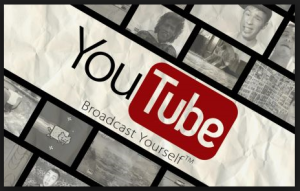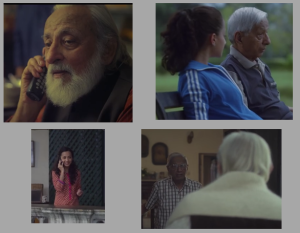Have you seen many new web video marketing examples lately? We are interested in how many persuaded you on the company behind them. It is amazing how much video marketing has grown over the past 5-10 years or so, isn’t it? Here are three unique video marketing examples we have selected to discuss. After reading the discussion, please let us know what you think.

Note that this is a long article. If you would like me to send you a copy, please send me your email in a note requesting a copy. Mike@digitalsparkmarketing.com
Webvideo … Example 1 Warby Parker
We are always on the lookout for creative ideas for doing standard things. Standard things like annual reports of companies. Enter Warby Parker and its application of visual content design to its most recent annual report.3
Never heard of Parker Warby? As they write in their website, Warby Parker was founded with a rebellious spirit and a lofty objective: to create boutique-quality, classically crafted eyewear at a revolutionary price point.
Related post:14 Jaw-Dropping Guerilla Marketing Lessons and Examples
Eyewear with a purpose
Almost one billion people worldwide lack access to glasses. This means that 15% of the global population cannot effectively learn or work – a problem that Warby Parker is determined to address. They’ve partnered with non-profits like VisionSpring to ensure that for every pair of glasses sold, a pair is distributed to someone in need.
Eyewear startup Warby Parker just released its Annual Report, a perfect example of how important tone is in creating great visual content. This very different approach to a year-end report uses a calendar format, highlighting company events on each day. Some events are significant company milestones; others are little anecdotes showcasing office life and culture.
Wow … what a change from the typical financial results and strategic initiatives that typically fill the pages of annual reports.
The report is an excellent example of a brand showcasing its ideas, creativity, and culture in a visually engaging way. At its core, the strategy of content marketing is not just about distribution and visibility. It is about telling the world who you are and what you stand for. This design goes a long way in turning customers into brand advocates.
The design shows how to empower your content. So many companies just don’t take advantage of their great content or they don’t know how to present their content in a creative way. Often, in the end they are fighting for survival like we all are. However the brands that can express their personality, their creativity, passion, and manage their content in a way that speaks to people will create loyal customers.
Here are 9 important takeaways all brands can learn from Warby Parker’s design approach to creating great content.

Push the edge to be different
What does the Warby Parker class trip have to do with eye glasses? What does it matter? It is an interesting story and Warby Parker uses the story to illustrate its personality and culture. Your content should be relatable, valuable and interesting for your audience. If you capture these qualities, your marketing will create a captive audience with ever-increasing brand loyalty.
Utilize visual design
First and foremost, prioritize visual design in your efforts. Presenting your content in a visual format has a number of benefits. First, humans recognize and process images much faster than text; this is why visual content has much greater appeal. A study by 3M showed that 90% of the information sent to the brain is visual, and visuals are processed 60,000 times faster than text.
Second, using a diversity of image types makes your content continuously fresh, which encourages readers to explore more. In the Warby Parker design the combination of photography, illustration, videos and data visualization keeps the eyes interested and moving around the page. More time on site means more engagement with your brand.
Apply data in comparison
If you are going to visualize data, display a comparison—that is what makes visualization more meaningful. The infographics revolution has brought with it many a missed data visualization opportunity in the form of single-data-point pie charts and big numbers with fancy typographic treatment. Distilling data into a statistic removes the context and comparison that makes it insightful. Don’t fear complexity; take advantage of the opportunity to add clarity with many visualization design elements.
Show Your Personality
Business is becoming increasingly personal—not in the waiter remembers my name sort of way, but more in the way that we crave more personal connection in a web-based world. People want to know that the businesses they support are run in a way they can relate to, that its employees are people they might hang out with and potentially even someone who could become a good friend.
Marketing content is all about making connections. Your level of success has a lot to do with how your readers react to what you write. People connect with your brand because they relate to what you’re saying to them. They want to feel that your content is specifically crafted with their interests and needs in mind. In other words, it should feel personal.
Show off your people
Your customer community wants to know that there are humans behind your brand, and they want to know more about them as people. Don’t make the mistake of hiding your people, relationships, interactions and office pranks behind a shield of professionalism. These things are most often as interesting as your products and services … and certainly as how much money you made last year. In today’s marketing landscape, whether you are a product or service-oriented business, you are selling your culture, and your culture is your people.
The growth in content consumption is not just because people are looking for a satisfactory distraction from work. Customers have an appetite for real, interesting information. The vast knowledge-sharing that the web has facilitated has brought with it an increased curiosity and hunger for understanding. Don’t believe that everything you do in the back end of your business is boring. Turn it into engaging content that will deepen your customers’ understanding of what your world is all about.
Create emotion
In his book Contagious, Wharton professor Jonah Berger showed that one of the key reasons people share creative content is because it arouses a person’s emotion. His point is… content has to go beyond just being useful; it has to be unforgettable. Rather than trying to churn out quantity, take the time to figure out what kind of emotions move your audience.
In doing so, it’s important to remember that not all emotion is created equal. In his research, Berger identifies that certain kinds of emotions – those that get people “aroused” like awe, passion, and anger – are much more likely to drive shares than those that make people feel toned down – like sadness, relaxation, or contentment.
Don’t be afraid to shake things up. Like in all elements of the Warby Parker annual report.
Integrate products/services naturally
Your products and services don’t have to be ignored. In the midst of all the other ways to add to your design, you often can overlook them. Feature your product or service naturally within content, but don’t make it an abrupt deviation from the other fun stuff.
This means that you will want to tone down your calls to action and any other hard-sell tactics. Use them as an opportunity to remind viewers what you do, without killing all those good vibes you have been building.
Share how you are awesome
One important element of marketing is about bringing attention to how awesome you are. However, this doesn’t mean your awesomeness-recognition abilities should be limited to your own pursuits. Calling out the big (and little) wins of others—vendors, customers, ex-employees, maybe even competitors—shows that you are not afraid to give credit where it is due.
This fresh perspective will add authenticity to your content.
Amplify who you are
Your content is a perfect place to let your audience know why you do what you do. Clearly articulating the values that give your company meaning helps you connect with people on a level beyond the business transaction, and it attracts people that share those same ideas. This powerful means of communication helps truly differentiate your brand—more than low prices and fancy features could ever do.
Web Video … example 2 Magic of the Samsung marketing campaign for curved TV
Have you occasionally watched extraordinary commercials that totally captivated you? Not too often, you say? But still it happens, doesn’t it? A lot of the captivation is about feelings and simple, meaningful messages that interest and entertain. Have you noticed the commercials for the Samsung marketing campaign for its Curved TV? Certainly interesting and entertaining for a 60-second spot.
Check out the Samsung commercial … it is a short 60 seconds. You will be impressed.
I’ve done marketing for my clients in small businesses for the past 4+ years and I’ve learned a few things about making advertising look captivating and entertaining even on a tight budget. And the true measure of successful advertising design is having customers remember and talk about the message. Captivate your audience like this Samsung commercial. Sure, you don’t have the talent or budget like Samsung, but by learning what makes this marketing campaign successful, you can apply the principles to your marketing objectives.
In marketing or advertising, you need to create information that your customers find interesting and worth talking about and remembering.
Samsung Electronics unveiled a new marketing campaign highlighting its new Curved UHD TV. The campaign “The Curve Changes Everything” combines new ideas with its smartphone campaign which we have previously written about, entitled “The Next Big Thing Is Here”.
In my favorite commercial in this campaign Samsung collaged memorable moments from film, television, and the Internet to tell a visual story. The story depicts the emotion, wonder and excitement that viewers experience when watching their favorite content on a Samsung Curved TV.
They use one of the oldest techniques in commercials: applying snippets of dialogue from films and TV shows out of context, so the characters appear to be surprised or impressed by something marketing.
It certainly still works, particularly when it’s done well. And this Samsung spot certainly has captured the magic of this technique.
Let’s examine some of the additional reasons this is such a remarkable commercial contributing to the success of the Samsung marketing campaign:
Video online … grab and hold viewers’ attention
Interesting information gets and holds attention. Keep in mind that people don’t read ads … they read what interests them. When this commercial opens, you immediately see a movie snippet of a Jurassic Park actor. Immediately you are trying to remember the scene and movie.
So they are being different … avoiding normalcy at all costs.
Stand out is the mantra. It’s OK to be controversial and to create conversation through the ‘buzz’. Commercial beginnings are the first place for attention and using curiosity in this fashion amplifies the attention.
Emotional influence and persuasion
There are no better means of influence or the power of persuasion than emotion. Hands down the best, in my opinion. But few commercials employ it. Experiences that trigger our emotions are saved and consolidated in lasting memory because the emotions generated by the experiences signal our brains that the experiences are important to remember.
Just like the movie snippets used here. Capture the emotion in all the snippets used. They work well in getting you into the emotion, don’t they?
Film segments
The commercial features iconic scenes from movies like Back to the Future, Jurassic Park, Jaws, Field of Dreams, and more—with the characters appearing to marvel over the beauty of Samsung’s Curved UHD TV. What a great way to highlight several of the commercials’ advantages jointly.
Clean, simple messages
Make the message as clean and simple as possible. You cannot overachieve on the simplicity of the message. A message that the reader will quickly understand. Keep in mind that pictures are far more valuable than words. And the messages of this commercial shown visually on the Samsung curved TV clearly stand out.
Define a strong unique selling proposition
A unique selling point that truly discriminates you from your competition. Several unique selling propositions are brought to life visually on the TV itself (even visible as a picture). It is essential that you give your customers reasons to select you. Paint the picture of value … make the value stand out. Value of the TV visuals stand out throughout the commercial, don’t they?

Superb visual elements
Using pictures/visuals to convey the messages is much better than words. “Seeing is believing” and “actions speak louder than words” are two common sayings that reflect a bias and preference for visual presentation. Seeing is certainly believing with these movie clips shown on the TV. As Kevin Costner puts it “It’s beautiful, but it’s more than that. It’s perfect.”
Tell a story
In this commercial, Samsung tells an inspiring story to convey its emotional influence. Like great stories, it has a beginning where sympathetic characters encounter complicating situations, a middle where the characters confront and attempt to resolve the situation, and an end where Costner reveals the outcome. It does not interpret or explain the action in the story to the audience. The story stands on its own.
The story allows each member of the audience to interpret the story and its emotion as he or she understands the action. This is why people find good, emotional stories so appealing and why they find advertising that simply conveys facts and information boring.
Define your positioning
Your positioning is the current frame of reference. In this case, no competitor needs to be mentioned. The claim is that the technology is only available with Samsung. And the punchline? The next big thing is here and the curve changes everything. The positioning doesn’t get any better than that, does it?
So remember this:
It is not what advertising does with the consumer; it is what the consumer does after digesting the advertisement. After looking over this commercial … how much can you apply what you have learned?
